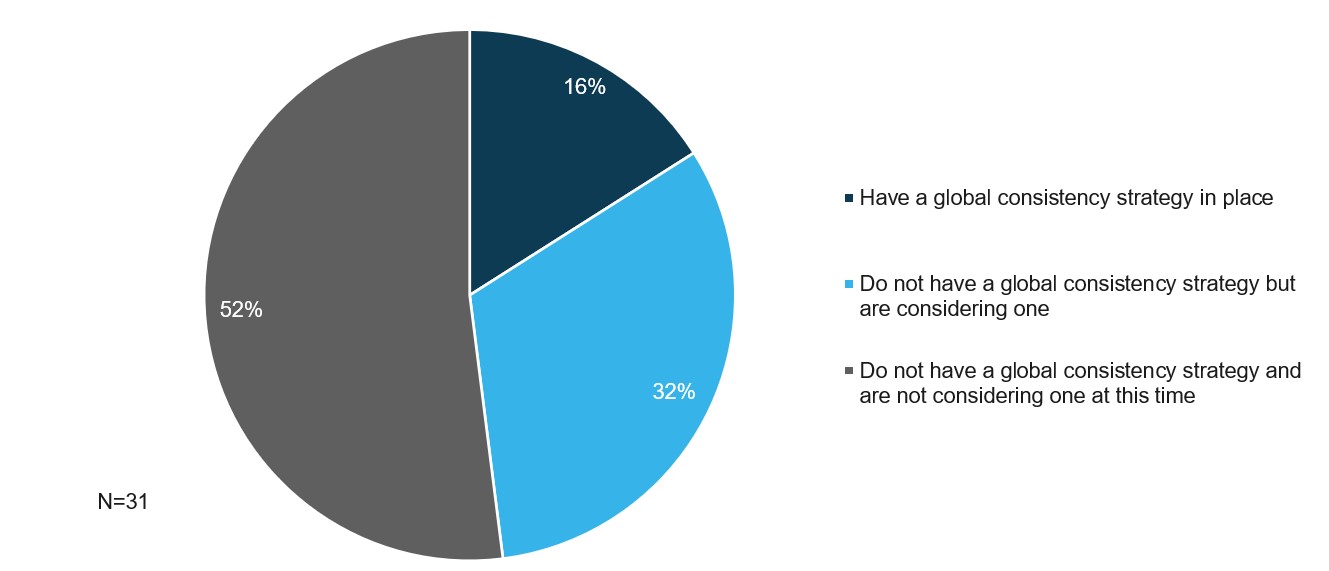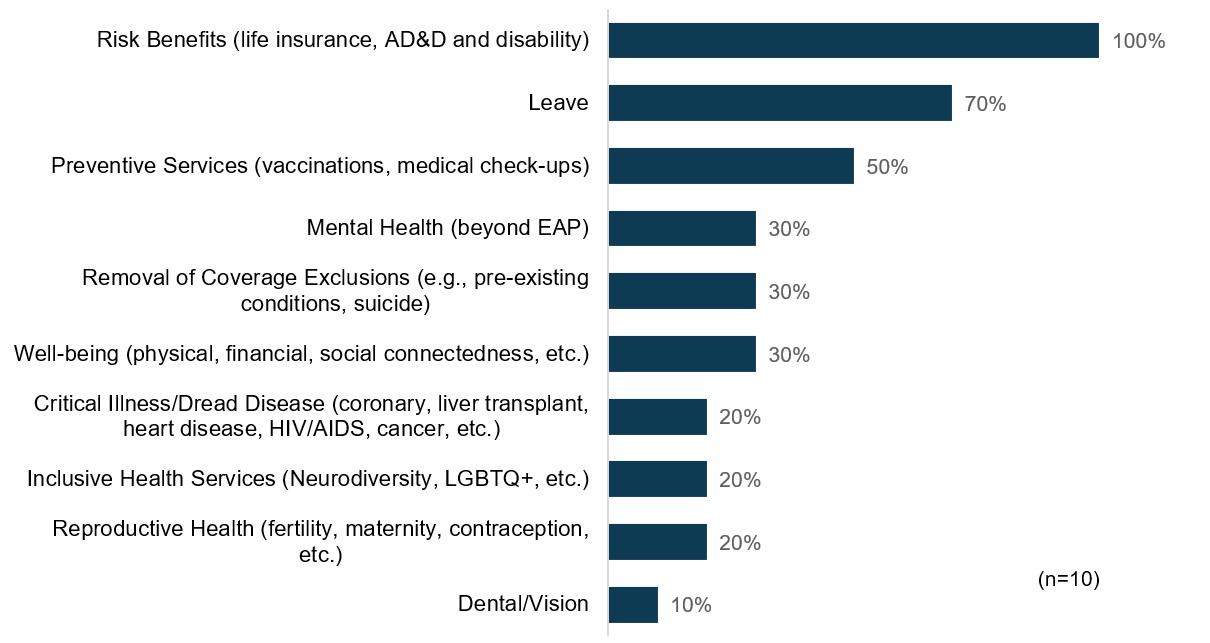June 30, 2023
In Business Group on Health’s survey, 16% of participants stated that they had a global consistency strategy in place, while another 32% are considering implementing one (Figure 3.1).1 The most common benefits employers included in their strategy are risk benefits, leave and preventive services (Figure 3.2).2 Some employers have core standards for mental health and removal of coverage exclusions.
The common global core standards employers are utilizing include:3
- Life insurance lump sum of 1x annual basic pay;
- Accidental death lump sum of 1x annual basic pay;
- Disability lump sum of 1x annual basic pay;
- Maternity leave minimum of 16 weeks; and
- Paternity leave minimum of 5 days.


Source: Employer-Sharing Discussion: Global Benefits - May 2022
Well-being continues to be an area of growth, as employers continue to look more holistically at delivering wellness offerings and initiatives that are language and culturally appropriate. In the 14th Annual Employer-Sponsored Health and Well-being Survey: Well-being’s Path Forward report, two-thirds of employers have a globally consistent well-being strategy. For example, in the Middle East, some employers provide physical activity alternatives to outdoor walking or step challenges when it is too hot to walk outside. Best Employer Award winning companies have global consistency standards for mental health, physical well-being, leave, preventive services, financial well-being, LGBTQ+ services and reproductive health services.
It is important to be intentional when determining what to include in your strategy. Take a moment to audit what is currently offered and its real and perceived value proposition.
- Are there any benefits that through their design and eventual implementation should be added to your roadmap, as they would create a more equitable and diverse environment?
- What are your cost limits and restrictions? Should the benefit include cost-sharing components? Are there financing options or other efficiencies to leverage that could help fund coverage gaps?
- Where does the benefit fall within your strategy spectrum?
Table 3.1 provides additional questions to guide your decision-making for health care and leave standards.
Table 3.1: Question Guides for Developing Minimum Standards
|
Health Care |
Global Leave |
|---|---|
|
Does the market infrastructure support the ability to deliver the desired services? |
Which leaves should be prioritized? |
|
Is the service affordable to employees? |
What are the statutory requirements and market median offering for the leave? |
|
Is the service of sufficient quality for employees? |
Is the leave paid by the employer, government program subsidy or unpaid?
|
|
What does best-in-class coverage look like? |
What are the eligibility criteria (i.e., tenure, full-time vs. part-time)? |
|
What access do employees have to the recommended services? And is that access acceptable to meet or override the cultural needs and standards of the community (e.g., addresses issues of stigma and discrimination in the case of HIV, mental health services and Hepatitis B)? |
How much would a paid leave benefit cost compared to total benefits spend? |
Employer Example
Microsoft has created a medical top-up plan called Health Plus Plan that provides coverage for health needs such as congenital birth defects that have either restrictive caps or coverage limitations.4 The company utilizes its captive to fund this program.5 Separately, Microsoft went through an audit of its existing medical plans under its captive to remove pre-existing conditions (e.g., HIV/AIDS).5 The company is currently focused on providing preventive health service offerings through its captive.5
When determining which programs to prioritize, remember that the offerings can be additive within a multiyear strategy. Therefore, have your consultant or local team share global legislative updates regularly, since these can ultimately change and potentially enhance your offerings. For example, Spain launched menstrual leave and many countries have developed regulations for remote working arrangements.6,7 Ask yourself what big picture results you want to achieve in the next 3-5 years and what programs you can implement sequentially while keeping careful and thoughtful attention to overall cost.
More Topics
Articles & Guides- 1 | Business Group on Health. Quick survey findings: Global consistency strategy. November 17, 2021. https://www.businessgrouphealth.org/resources/quick-survey-findings-global-consistency-strategy. Accessed May 5, 2023.
- 2 | Business Group on Health. Employer-sharing discussion: Global benefits. May 13, 2022. https://www.businessgrouphealth.org/en/resources/key-insights-global-benefits-5422. Accessed May 5, 2023.
- 3 | Bateman N. Global priorities for employee benefits: An HQ perspective for 2023. Willis Towers Watson. November 3, 2022. https://www.wtwco.com/en-us/insights/2022/11/global-priorities-for-employee-benefits-an-hq-perspective-for-2023. Accessed March 5, 2023.
- 4 | Kawamoto D. 5 important takeaways from Microsoft’s HR strategy. HR Executive. May 3, 2023. https://hrexecutive.com/5-important-takeaways-from-microsofts-hr-strategy/. Accessed May 15, 2023.
- 5 | Cutcher R, Lampi S, Tropea A. GCP #63: Elke Vagenende, Microsoft’s captive strategy and CICA’s Dane Towle. Global Captive Podcast. March 13, 2022. https://www.globalcaptivepodcast.com/episodes/episode/8e4cfa13/gcp-63-elke-vagenende-microsofts-captive-strategy-and-cicas-dan-towle. Accessed May 31, 2023.
- 6 | Nadworny K. Spain requires paid menstrual leave. Society for Human Resource Management. April 25, 2023. https://www.shrm.org/resourcesandtools/hr-topics/global-hr/pages/spain-paid-menstrual-leave.aspx. May 3, 2023.
- 7 | New remote working legislation around the world. Lockton Global Compliance. June 28, 2023. https://globalnews.lockton.com/new-remote-working-legislation-around-the-world/. Accessed June 29, 2023.
-
IntroCreating a Globally Consistent Benefits Strategy
-
Part 1What Is Global Consistency, and Why Is It Important?
-
Part 2Harnessing Long-Term Global Consistency Opportunities
-
Part 3Benefits to Include in a Global Consistency Strategy
-
Part 4Utilizing Financing Mechanisms to Implement a Global Consistency Strategy
-
Part 5Prioritizing and Advancing a Globally Consistent Vision
This content is for members only. Already a member?
Login
![]()
